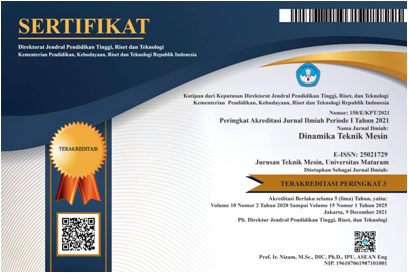The effect of fins on PCM containers on solar panel cooling performance
Abstract
Keywords
Full Text:
PDFReferences
Achmad, M.I., Analisa pengaruh pendingin panel surya 50 Wp terhadap daya yang dihasilkan, Sultra Journal of Mechanical Engineering (Sjme), 2(1), 8-16, 2023.
Arifin, Z., Khairunisa, N., Kristiawan, B., Prasetyo, S.D., Bangun, W.B., Performance analysis of nanofluid-based photovoltaic thermal collector with different convection cooling flow, Civil Engineering Journal, 9(8), 1922-1935, 2023.
Arifin, Z., Tjahjana, D.D.D.P., Hadi, S., Rachmanto, R.A., Setyohandoko, G., Sutanto, B., Numerical and experimental investigation of air cooling for photovoltaic panels using aluminum heat sinks, International Journal of Photoenergy, 2020.
Awan, M.M.A., Javed, M.Y., Asghar, A.B., Ejsmont, K., Performance optimization of a ten check MPPT algorithm for an off-grid solar photovoltaic system, Energies, 15(6), 2104, 2022.
Benitez-Lara, A., Bautista-Bustamante, E., Morales, F., Moreno, M., Mendoza-Ramirez, M.C., Morales-Sánchez, A., Hernández-Orihuela, L., Antonio, A.M., Synergistic effects of vegetal melanin and porous silicon powder to improve the efficiency of solar panel, Solar Energy, 287(October 2024), 1-7, 2025.
Dahliya, D., Samsurizal, S., Pasra, N., Efficiency of a 100 Wp capacity solar panel due to the effect of temperature and wind speed, Jurnal Ilmiah SUTET, 11(2), 71-80, 2021.
Denk, T.M.S., Pandria, T.M.A., Firnanda, A., Identifikasi pengaruh penggunaan heatsink terhadap keluaran modul surya, Jurnal Optimalisasi, 8(2), 200, 2022.
Harahap, C.R., Pengendalian kecepatan motor induksi 3 fasa dengan sumber panel surya, Jurnal Informatika dan Teknik Elektro Terapan, 11(3), 2023.
Laksana, E.P., Sanjaya, O., Sujono, S., Broto, S., Fath, N., Sistem pendinginan panel surya dengan metode penyemprotan air dan pengontrolan suhu air menggunakan peltier, Elkomika Jurnal Teknik Energi Elektrik Teknik Telekomunikasi dan Teknik Elektronika, 10(3), 652, 2022.
Li, D., Yang, X., Wang, S., Duan, D., Wan, Z., Xia, G., Liu, W., Experimental research on vibration-enhanced heat transfer of fin-tube vehicle radiator, Applied Thermal Engineering, 180(February), 115836, 2020.
Machi, M.H., Al-Neama, M.A., Buzás, J., Farkas, I., Energy-based performance analysis of a double pass solar air collector integrated to triangular shaped fins, International Journal of Energy and Environmental Engineering, 13(1), 219-229, 2021.
Monika, D., Muchlishah, M., Nadhiroh, N., Indra, Z., Mulyadi, W.H., Tiar, M., Prediksi energi pada panel surya offgrid 400 Wp menggunakan software PVSyst, Electrices, 5(1), 36-43, 2023.
Mulyadi, D., Dewadi, F.M., Amir, M., Murtalim, Khoirudin, Analisis rancangan sel surya untuk kebutuhan cadangan energi listrik di kolam wilayah Graha Raya Bintaro, Tangerang Selatan, Jurnal Teknik Mesin Mechanical Xplore, 2(1), 6-12, 2021.
Nadjib, M., Caroko, N., Thoharudin, T., Darmawan, H., Investigasi kapasitas energi termal pada solar water heater berbasis kalor laten dengan variasi debit air, Semesta Teknika, 26(1), 28-40, 2023.
Ngonda, T., Perceptions of solar photovoltaic system adopters in sub-Saharan Africa: A case of adopters in Ntchisi, Malawi, Energies, 16(21), 7350, 2023.
Olabi, A.G., Abdelkareem, M.A., Renewable energy and climate change, Renewable and Sustainable Energy Reviews, 158(November 2021), 112111, 2022.
Pulungan, A.B., Sardi, J., Hamdani, H., Hastuti, H., Pemasangan sistem hybrid sebagai penggerak pompa air, JTEV (Jurnal Teknik Elektro dan Vokasional), 5(2), 35, 2019.
Saputra, Y.M.D.E., Ramadhan, M.T.N., Performance study of monocrystalline type solar panels for street lighting in Sibolga area, Motivection Journal of Mechanical Electrical and Industrial Engineering, 5(2), 205-216, 2023.
Seto, D.B., Arifin, Z., Kristiawan, B., Prasetyo, S.D., Nanoparticle-enhanced phase change materials (NePCM) in passive cooling systems to improve solar panel efficiency, International Review of Mechanical Engineering, 18(1), 20-27, 2024.
Subekti, F., Wahyudi, S., Gapsari, F., Pengaruh geometri dan penambahan jumlah sirip terhadap distribusi temperatur heat sink sebagai alternatif pendinginan pada piranti elektronik, Jurnal Rekayasa Mesin, 14(3), 939-952, 2023.
Veva, M.R.A., Fitri, S.P., Wardhana, E.M., Analisis karakteristik dan sifat termofisika phase change material (PCM) berbasis salt hydrate kalsium klorida dengan zat aditif untuk aplikasi sistem refrigerasi hybrid pada reefer container, Jurnal Teknik ITS, 12(3), 2023.
DOI: https://doi.org/10.29303/dtm.v15i1.1035
Refbacks
- There are currently no refbacks.
Copyright (c) 2025 Open access

This work is licensed under a Creative Commons Attribution-NonCommercial 4.0 International License.






















